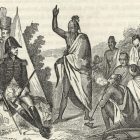Fort Jackson
Fort Jackson
Fort Jackson and Fort Toulouse are two forts that shared the same site at the fork of the Coosa River and the Tallapoosa River, near Wetumpka, Alabama. The last of a series of forts built, Fort Jackson was the scene of some of the most significant events in American history. Fort Jackson was established in April of 1814 by Major General Andrew Jackson of Tennessee.
After Jackson defeated the Red Stick faction of the Creek Nation he moved his army into the heart of the Creek Nation and built Fort Jackson.
During the War of 1812, “Red Stick” Creek Indians of northern Alabama and


Georgia attacked white settlements and killed over 400 settlers at Fort Mims. In the resulting Creek War, General Andrew Jackson commanded the combined American forces of Tennessee militia, U.S. regulars, and Cherokee and Southern Creek “White Stick” Indians.
Jackson defeated the Red Stick Creeks at the Battle of Horseshoe Bend in 1814, and afterwards initiated construction of a fort atop the site of the old French fort at the confluence of the Coosa and Tallapoosa rivers. The fort was intentionally built near the sacred Creek site known as the Hickory Ground.
Jackson then temporarily traveled to Washington and in his absence, the fort
 was named “Jackson” in his honor. After Jackson’s return, he imposed the Treaty of Fort Jackson upon both the Northern Creek enemies and the Southern Creek allies, wresting 20,000,000 acres in much of the modern states of Alabama and Georgia from all Creeks.
was named “Jackson” in his honor. After Jackson’s return, he imposed the Treaty of Fort Jackson upon both the Northern Creek enemies and the Southern Creek allies, wresting 20,000,000 acres in much of the modern states of Alabama and Georgia from all Creeks.
Now a part of Fort Toulouse-Fort Jackson Historic Site, Fort Jackson has been partially restored. The park is located at the end of Fort Toulouse Road off U.S. Highway 231 inWetumpka, Alabama.
